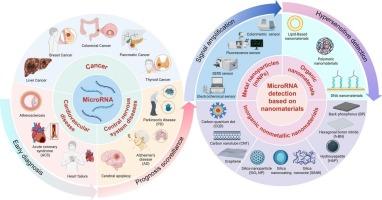纳米材料驱动超敏microRNA检测在临床精准医学中的应用
IF 13.2
1区 工程技术
Q1 ENGINEERING, CHEMICAL
引用次数: 0
摘要
MicroRNAs (miRNAs)是一类短的非编码RNA分子,在转录后基因调控中起关键作用,已成为危重疾病早期诊断和治疗监测的宝贵生物标志物。然而,它们固有的低丰度和高序列同源性使得通过定量聚合酶链反应和微阵列等传统方式进行检测具有挑战性。基于纳米材料的生物传感技术的最新进展彻底改变了miRNA检测,使超灵敏、多路和实时分析成为可能。本文阐述了miRNA的生物发生、调控机制和临床意义,并讨论了纳米材料驱动的超敏miRNA检测策略,用于潜在的临床精准医学,重点是纳米结构可以增强信号放大、特异性和通量,同时解决传统检测方法的关键局限性。未来的研究应该集中在环保纳米复合材料、人工智能驱动的数据解释和用于临床诊断的芯片实验室设备的开发上。通过协同纳米工程与临床需求,本综述强调了纳米材料在促进个性化医疗和精准医疗中基于微rna的诊断方面的范式转变作用。本文章由计算机程序翻译,如有差异,请以英文原文为准。

Nanomaterial-driven hypersensitive microRNA detection for clinical precision medicine
MicroRNAs (miRNAs), a class of short non-coding RNA molecules that are pivotal in post-transcriptional gene regulation, have emerged as invaluable biomarkers for the early diagnosis and therapeutic surveillance of critical diseases. However, their inherently low abundance and high sequence homology make detection through conventional modalities, such as quantitative polymerase chain reaction and microarrays, challenging. Recent advancements in nanomaterial-based biosensing have revolutionised miRNA detection, enabling ultrasensitive, multiplex, and real-time analyses. This review elucidates the biogenesis, regulatory mechanisms, and clinical implications of miRNAs and discusses nanomaterial-driven hypersensitive miRNA detection strategies for potential clinical precision medicine with emphasis on nanostructures that enhance signal amplification, specificity, and throughput while addressing the critical limitations of traditional detection methods. Future research should focus on the development of eco-friendly nanocomposites, artificial intelligence-driven data interpretation, and lab-on-a-chip devices for clinical diagnosis. By synergising nanoscale engineering with clinical demands, this review highlights the paradigm-shifting role of nanomaterials in promoting microRNA-based diagnostics in personalised healthcare and precision medicine.
求助全文
通过发布文献求助,成功后即可免费获取论文全文。
去求助
来源期刊

Chemical Engineering Journal
工程技术-工程:化工
CiteScore
21.70
自引率
9.30%
发文量
6781
审稿时长
2.4 months
期刊介绍:
The Chemical Engineering Journal is an international research journal that invites contributions of original and novel fundamental research. It aims to provide an international platform for presenting original fundamental research, interpretative reviews, and discussions on new developments in chemical engineering. The journal welcomes papers that describe novel theory and its practical application, as well as those that demonstrate the transfer of techniques from other disciplines. It also welcomes reports on carefully conducted experimental work that is soundly interpreted. The main focus of the journal is on original and rigorous research results that have broad significance. The Catalysis section within the Chemical Engineering Journal focuses specifically on Experimental and Theoretical studies in the fields of heterogeneous catalysis, molecular catalysis, and biocatalysis. These studies have industrial impact on various sectors such as chemicals, energy, materials, foods, healthcare, and environmental protection.
 求助内容:
求助内容: 应助结果提醒方式:
应助结果提醒方式:


